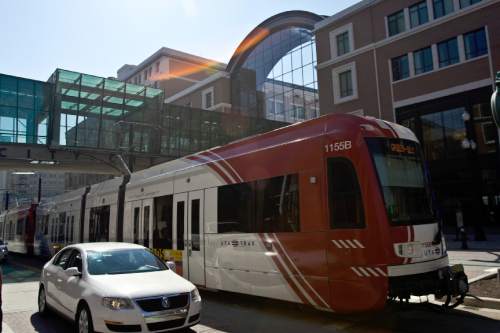This is an archived article that was published on sltrib.com in 2015, and information in the article may be outdated. It is provided only for personal research purposes and may not be reprinted.
The Utah Transit Authority had been playing catch-up all year, unable to match record ridership numbers set in 2014, but the agency finally overtook them slightly in August — although UTA is still well-short of its goal to increase ridership by 3.3 percent for the year.
Preliminary data released Wednesday showed that at the end of August, UTA had 30.16 million boardings on trains and buses for the year — 0.03 percent more than the 30.13 million it had at the same point last year.
That's a nice turnaround since May, when the agency was 1.8 percent behind last year's numbers. At that time, UTA officials blamed ridership decline largely on gasoline prices that dropped early in the year and may have lured more people back into their cars. Gasoline prices have been fairly stable since then.
"I think it's two things" that finally boosted ridership during the summer, said Matt Sibul, UTA chief planning officer. "It's been our fare promotions and added service."
UTA extended a promotion that was slated to end in June — but will now go through the end of the year — to offer a 20 percent discount on fares for those who use the agency's electronic FAREPAY card. That discount allows a one-way trip for $2 instead of $2.50.
In July, UTA also started offering a 40 percent discount for those who use FAREPAY cards to travel just on local buses, lowering a one-way fare to $1.50. The same month, the agency began selling group passes (for up to four people) for $10 a day, down from $15. These passes will be available through the end of the year.
Interim UTA President and CEO Jerry Benson told the UTA Board on Wednesday that the discount helped increase group-pass sales by 29 percent compared to the same time last year — and contributed an extra 17,363 boardings so far.
Over the summer, UTA also offered a "rider's license" pass to youths. It offered unlimited rides through the summer for $99; 70 percent of the passes were sold during an "early bird special," which offered them for $75. UTA sold 2,100 cards this year, compared to 802 last year, and users had 82,203 boardings.
Sibul said the other main reason for ridership increases is the extra service that the agency started offering in August, including expanded Sunday hours on all TRAX lines and the Sugar House streetcar.
"People are really using it," Sibul said of expanded hours on rail and some bus routes.
Initial data shows that for some of the improved routes, ridership is up by more than 30 percent on weekdays and 20 percent on weekends. UTA said official numbers will be released in coming weeks.
Sibul said the recent service expansion, funded in part from savings in lower fuel costs, "is a slice of our baseline proposal" for how UTA plans to use revenue from higher sales tax if voters approve Proposition 1 on Nov. 3.
Prop 1 would raise sales tax by a penny for every $4 in purchases. Forty percent of the money would go to UTA, and the rest would go to cities and counties for road and other projects. UTA estimates that Prop 1 would increase its revenues by 13 percent, or about $39 million a year.
UTA officials expect continued strong ridership numbers for September, in part because of continued good weather and the Comic Con convention — which helped set transit ridership records previously. In fact, they said ridership earlier in the year was likely down because Utah did not have an additional Comic Con event in April, as it did in 2014.
Also, Benson said strong ridership has come in September because of a partnership with the University of Utah that allows people attending football games to use their ticket as fare on transit.
U. home games on Sept. 3 and 11 helped produce one-day ridership of 91,763 and 98,954 boardings, respectively, compared to the average weekday ridership this year of 72,097.
Last year, UTA set its ridership record of 45.1 million boardings, up from 44.1 million in 2013. A boarding is constituted as every time a rider enters a train or bus. With transfers, it is possible for one trip to have several boardings.
The UTA board set a goal to increase ridership this year by 3.3 percent, one of eight formal goals that UTA administrators must meet to earn annual bonuses.



